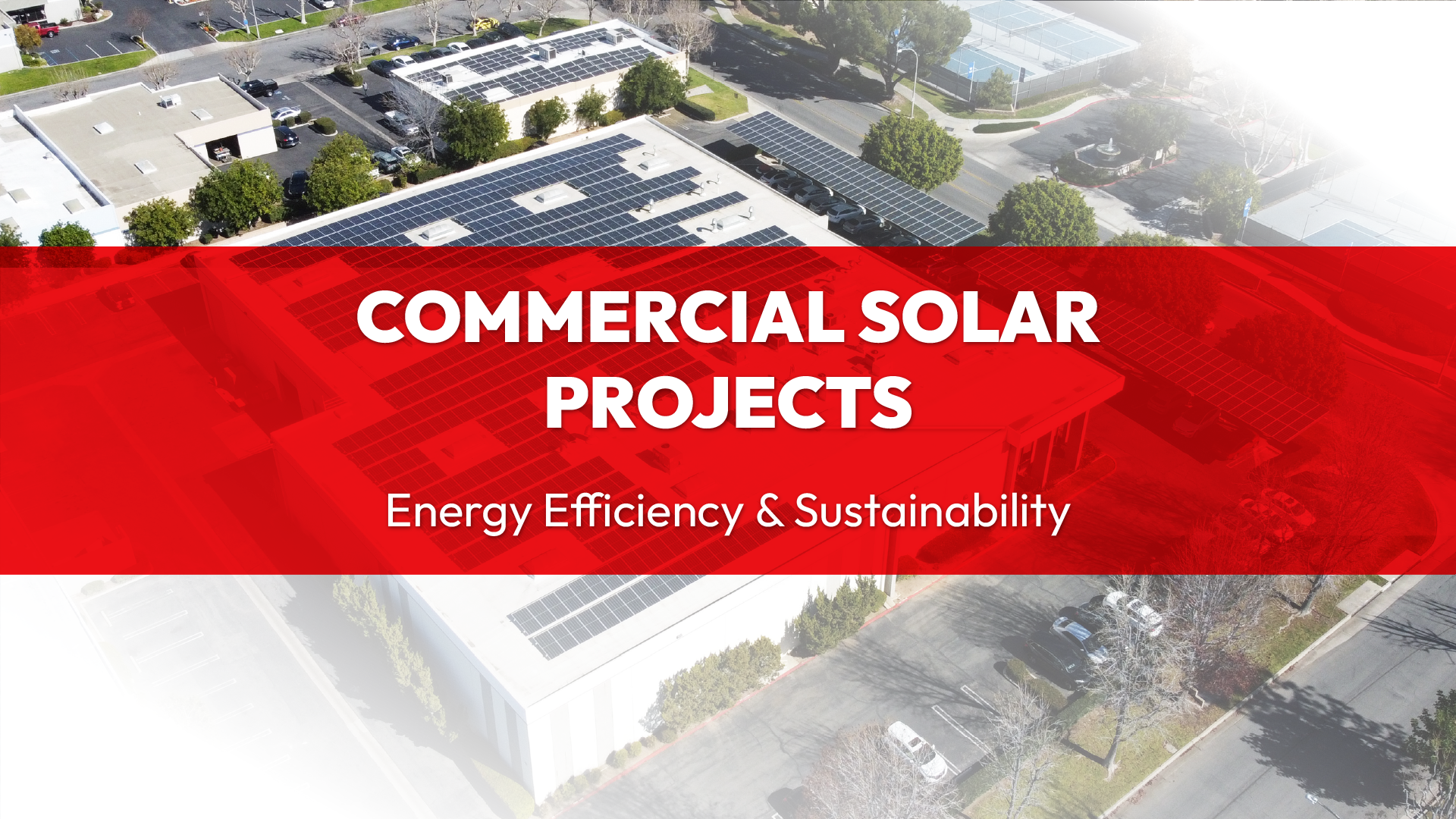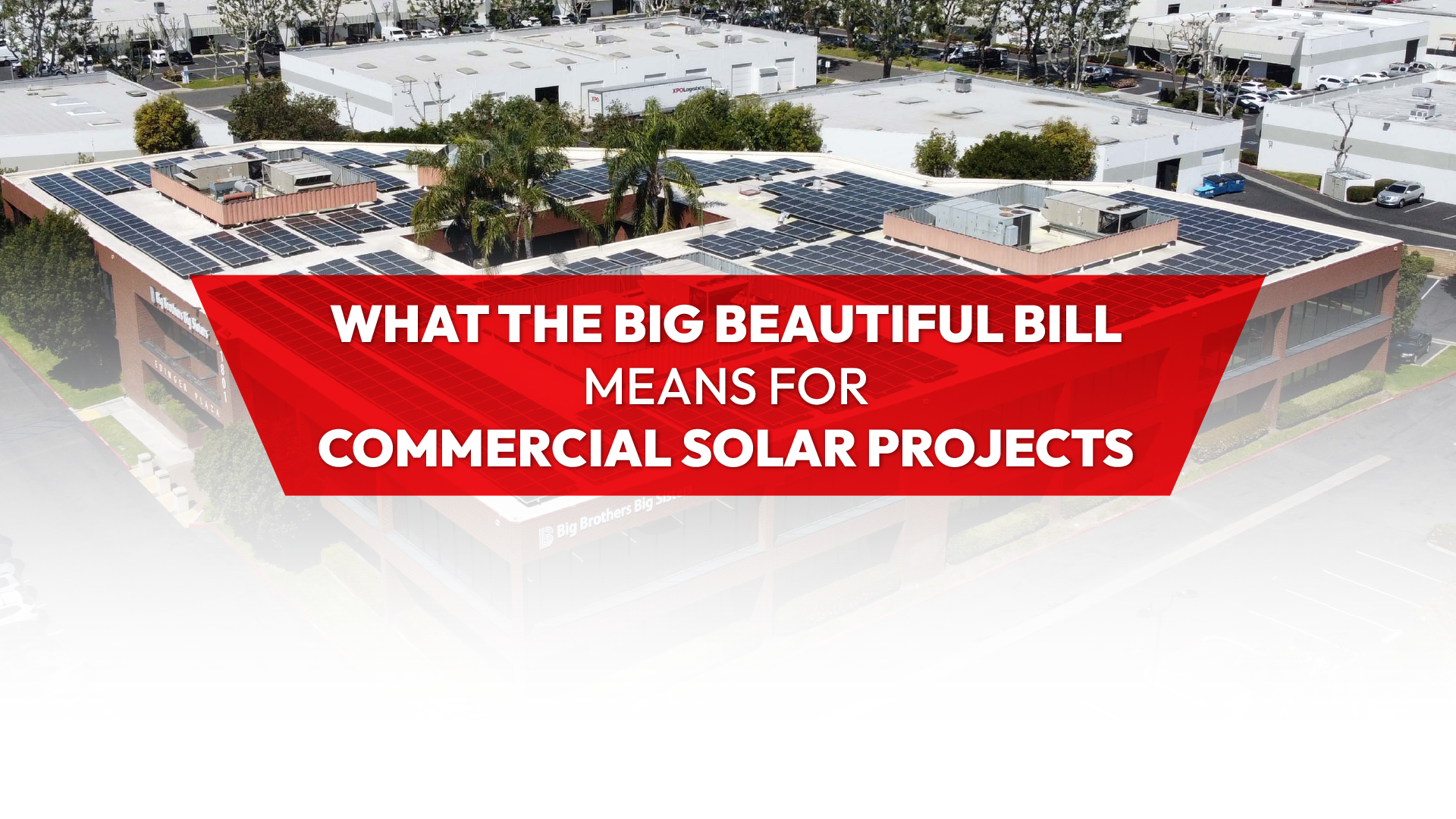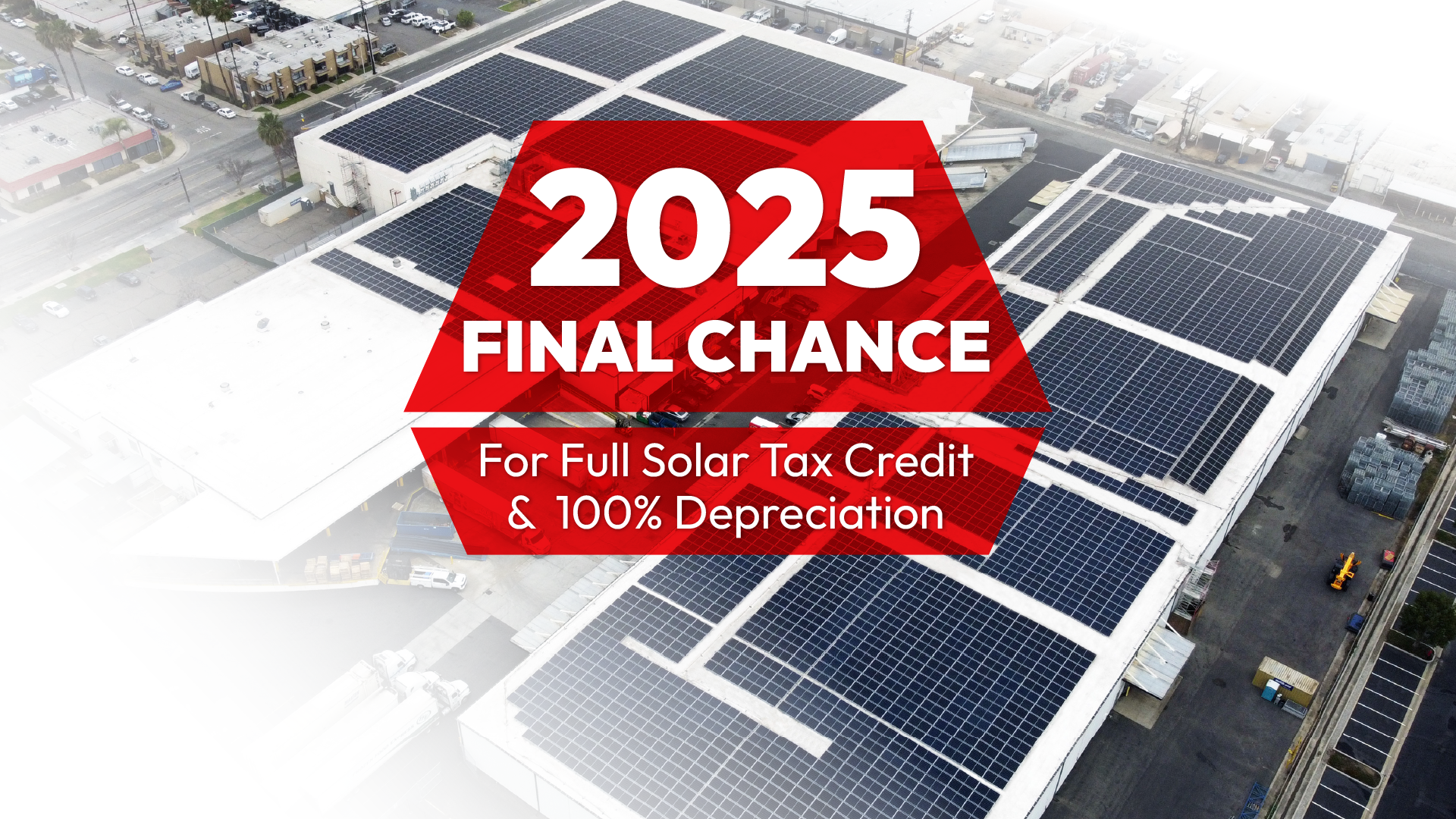Commercial Solar Frequently Asked Questions (FAQ)
Revel Energy has helped many businesses create capital through sustainability throughout California and through years of experience, we’re asked questions around commercial solar frequently. These frequently asked questions about commercial solar technology, benefits, incentives, bill savings, financing, construction, warranties, reliability, maintenance, and many more have helped businesses discover the value that can be found when investing into their future with clean and sustainable energy solutions.
Using renewable technologies like rooftop and ground-mounted commercial solar, energy storage systems, and EV charging stations, our team is dedicated to finding optimal solutions that result with increased cash flow in addition to current and future sustainability benefits that help make businesses more competitive.
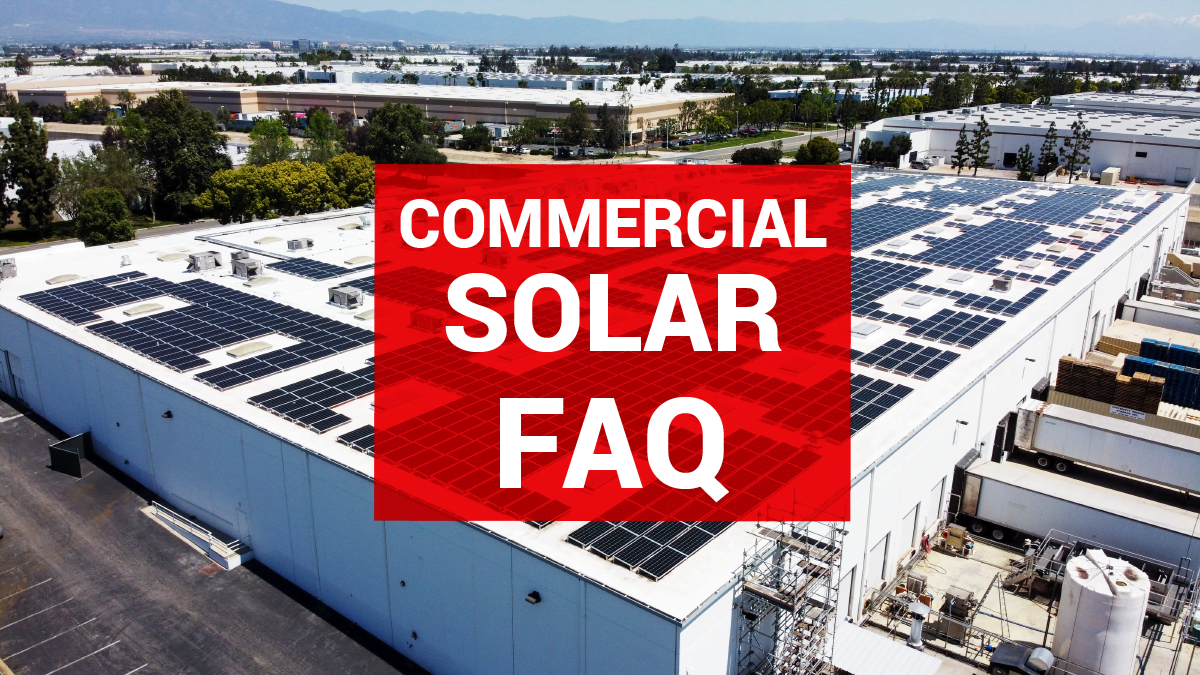
Frequently Asked Questions About Commercial Solar Systems
Setting aside the recognized environmental benefits, there are many financial benefits that make commercial solar a lucrative investment for many businesses. Programs and incentives that help pay for the system, offsetting current operating costs and reducing future electricity costs; commercial solar is a proven solution for many commercial, industrial and agricultural businesses in California and throughout the world.
Commercial solar systems reduce electricity bills by offsetting a building’s electricity use with solar energy generated from the sun; this offset results in significant savings throughout the life of the system, making the business more competitive. California’s electricity rates have consistently risen, but recently are growing faster than historical averages. A commercial solar system protects against a certain future of rising costs by offsetting electricity use throughout the system’s life.
Commercial solar, like other renewable energy resources, has many environmental benefits. Businesses reduce greenhouse gas emissions by using solar energy to offset their electricity use, which in turn, reduces air pollutants like sulfur dioxide and particulate matter produced through typical electricity generation, which have shown to cause health problems. Solar is more important now than ever, many businesses are looking forward and committing to a more sustainable future.
Yes, commercial solar is worth the price, worth the time investment, and worth the effort that it takes to get panels onto the roof of your business to reduce reliance on the utility. If your business can take advantage of the lucrative incentives, like the solar investment tax credit, the high return on investment and short payback periods quickly generates positive cash flow.
Larger than solar panels designed for residential use, photovoltaic commercial solar panels absorb the sun’s energy throughout the day, converting UV rays into direct current (DC) electricity. Most businesses run on alternating current (AC) electricity, so along with the solar panels, inverters are needed to convert DC to AC electricity for the building’s use.
No, solar energy generation is currently dependent on sunlight and can only generate electricity during the day. Other external factors like clouds and shading can affect the generation potential of a system. When paired with an energy storage system, any extra generated energy can be kept and used when needed rather than being used immediately as it was generated.
Interestingly, in a recent development to this frequently asked question about commercial solar; a team of engineers at Stanford University have developed a solar cell that can generate some electricity at night by incorporating a thermoelectric generator.
Solar panels are designed with no moving parts and durable tempered glass that requires little-to-no maintenance for the expected 25 to 35-year lifetime of the panels. Often, tier-1 commercial solar panels only lose about 15% of their efficiency over that lifetime.
Commercial, Industrial & Agricultural Electricity Cost FAQ
California businesses paying more than $3,000 on monthly electricity bills should consider commercial solar to help reduce their operating costs. Utilities intend to keep those costs on a rising trajectory through 2025, so the sooner a business considers commercial solar, they will create more savings into the future.
The easiest way to learn how much your business is paying for electricity is simply by referring to your utility electricity bill. Here’s a guide on how to read and make sense of your electricity bills. Commercial, agricultural and industrial businesses throughout California have witnessed their electricity costs rising dramatically, some businesses seeing up to 30% just from 2020 to 2022.
Electricity bills can be reduced drastically with a commercial solar system designed to offset the energy a facility would typically consume with solar power, instead of relying on the utility for. Unless a commercial solar solution is specifically designed with an energy storage system to be fully independent, you will likely still receive a small bill from your utility. Although with solar offsetting use, businesses are more protected against a certain future of rising electricity costs from your utility.
While commercial solar does an excellent job offsetting typical use, businesses that accrue demand charges would still have to pay their utility the high-costs of having enough energy available to meet spikes in demand. Energy storage systems can solve this problem through a process called Peak Shaving. By using reserve batteries to meet high-demand, instead of relying on your utility for quick bursts in demand for electricity, a commercial solar system paired with energy storage can shave its own peaks without incurring those pesky demand charges.
Net Energy Metering, NEM 2, is the system utilities use to credit solar energy system owners for the electricity produced by their solar panels, but cannot be used when that solar energy was generated. This program has seen a few iterations now and the newest on the horizon, NEM 3 or Net Billing, has drastically reduced the value of exported solar to the grid.
While it is possible to design a system that is separated from the grid with energy storage systems, it would cost significantly more to design that system with the safeguards, backups, and redundancy that the utility provides. A typical system is designed to tie-in to the grid, accessing utility power for when solar can’t generate electricity – like at night.
Financing Options & Incentives FAQ
While a cash purchase can monetize all incentives and benefits, our creative financing ream has helped businesses find ways to pay for the initial cost of the system through creative financing solutions like bank financing, power purchase agreements, commercial property assessed clean energy (CPACE) financing, lease-to-own financing, and power purchase agreements.
The most effective incentive available for commercial solar is the 26% federal investment tax credit (ITC), which allows businesses to deduct 26% of the overall system cost from their taxes. California State and Federal Bonus Depreciation is accessible and can help shorten payback periods. An incentive specifically for energy storage systems called the Self-generation incentive program (SGIP) has limited funds, but can still help add value to a commercial solar system by adding an energy storage system for better performance.
The Solar Investment Tax Credit, also known as the Solar ITC, is currently a 26% dollar for dollar credit calculated from the total cost of your commercial solar system. If the total cost is $500,000, your tax credit is worth $130,000 on your next year’s taxes. This incentive is scheduled to step down to 22% in 2023 and down to 10% in 2024.
Property FAQ - Commercial, Industrial & Agricultural Solar
More commercial buildings are embracing sustainable technologies like commercial solar, significantly increasing their property value – in addition to generating a positive cash flow with electricity bill savings. Even landlords with tenants on triple net and full service gross leases can add to their property value while simultaneously creating savings for their tenants.
If you own the building (not leasing), pay the utility bill, have a sunny rooftop of 100,000+ SF, are taxed on your business’ income, and the business can either self-finance or qualify for financing, then the building is a great candidate for solar.
There are different ways to mount solar panels to commercial building rooftops. If needed, we work with your roofer or a certified roofer to seal any penetrations made to maintain the existing warranty. If your roof needs replacement, we work with the roofer to incorporate the solar system into the warranty that will come with the roof.
Each solar module weighs approximately 54 lbs, evenly distributing the weight, we keep the weight per sf to 5 lbs. If you have your as-builts we can take a look at the live load listed on the specifications and tell you pretty easily if it can hold the weight. With newer buildings this is much less of an issue, but our team’s due diligence ensures the system fits the building. After we have a signed contract we conduct engineering and create a full set of plans that include structural load calculations to ensure the building can support the commercial solar system.
Repairs can typically take place without removing any solar modules. Your roofer can just work around the equipment since there is space and walkways to do so. However, if they need to repair an area covered by modules or if you need to re-roof, a coating is recommended. A coating, like silicone, can extend your roof life for 20+ years.
In the case of repairing an area covered by modules, it is best to remove the modules and have the roofer do their work, and then have the modules put back. This can be a bit costly; we estimate approximately $225 per module, to have the modules detached from the wiring, removed from the racking, and then reinstalled. To do a coating you can hire a roofer who is experienced in working around solar and they can coat the roof with the modules left in place, they will charge more for the additional time and preparation to do this.
Limited traffic will be on the roof unless modules or components require a replacement. Our chosen O&M service provider, Omnidian, can monitor your system 24/7 remotely and alert you to any issue, as well as deploy a service unit in the event of a problem. Panel washing is recommended 1 to 2 times per year and this would be one of the few times someone would be on the roof.
We Want To Know What Questions You Might Frequently Ask About Commercial Solar
At Revel Energy, our mission is to help California businesses generate capital sustainably, and key to our mission is answering the frequently asked questions around commercial solar system design, financing, and construction.
Our team thrives on problem solving and providing solutions to businesses with the ability to monetize sustainability with renewable solutions. We strongly encourage that you contact us with any questions you may have about your business and commercial solar.
Please consider taking our survey on commercial electricity use and it’s cost of doing business.
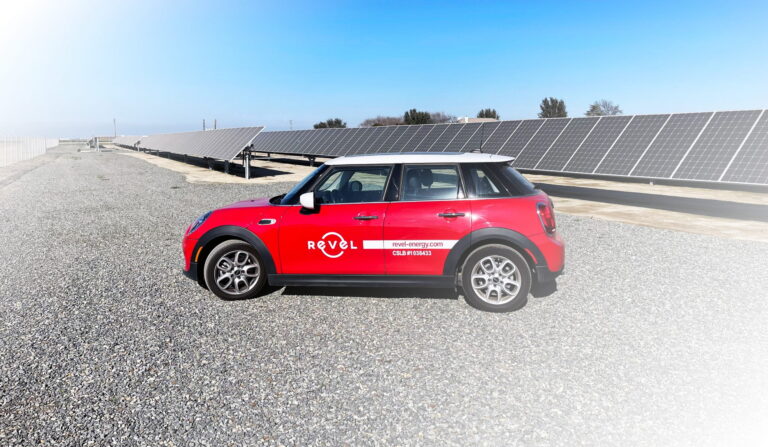
Commercial grade rooftop solar is ideal for: manufacturing, warehousing, logistics, industrial, retail, hospitality buildings and more with over 10,000 sq. ft. rooftops.
CARPORT SOLAR
Free standing carport solar generates added solar power for properties with limited rooftop space. Added benefits include shading and protection for employees vehicles.
Crucial for reducing peak demand charges. Automated to supply electricity when your panels won’t. Energy storage is ideal for businesses that incur significant peak charges.
As the popularity of electric vehicles increase, so does the demand for on-site charging. This sustainable amenity has become a parking lot fixture for competitive employers.
OUR SERVICES
TURNKEY COMMERCIAL GRADE SOLAR, ENERGY STORAGE, LED LIGHTING AND MORE.
PROFESSIONAL GUIDANCE
CUSTOM TAILORED PLANNING
CONSTRUCTION & INSTALLATION
CSLB #1106092
See how these businesses saved on electricity, gained valuable tax credits and rebates with commercial solar and energy storage.
Client Testimonial: Kelemen Company
Corporate Business Park in Irvine, CA has created significant electricity cost savings through commercial solar installed across the 5-building business park.
Client Testimonial: Tice Gardner & Fujimoto LLP
See how this CPA firm saved on electricity and gained valuable tax credits through commercial solar that they used to keep cash in the businesses.


